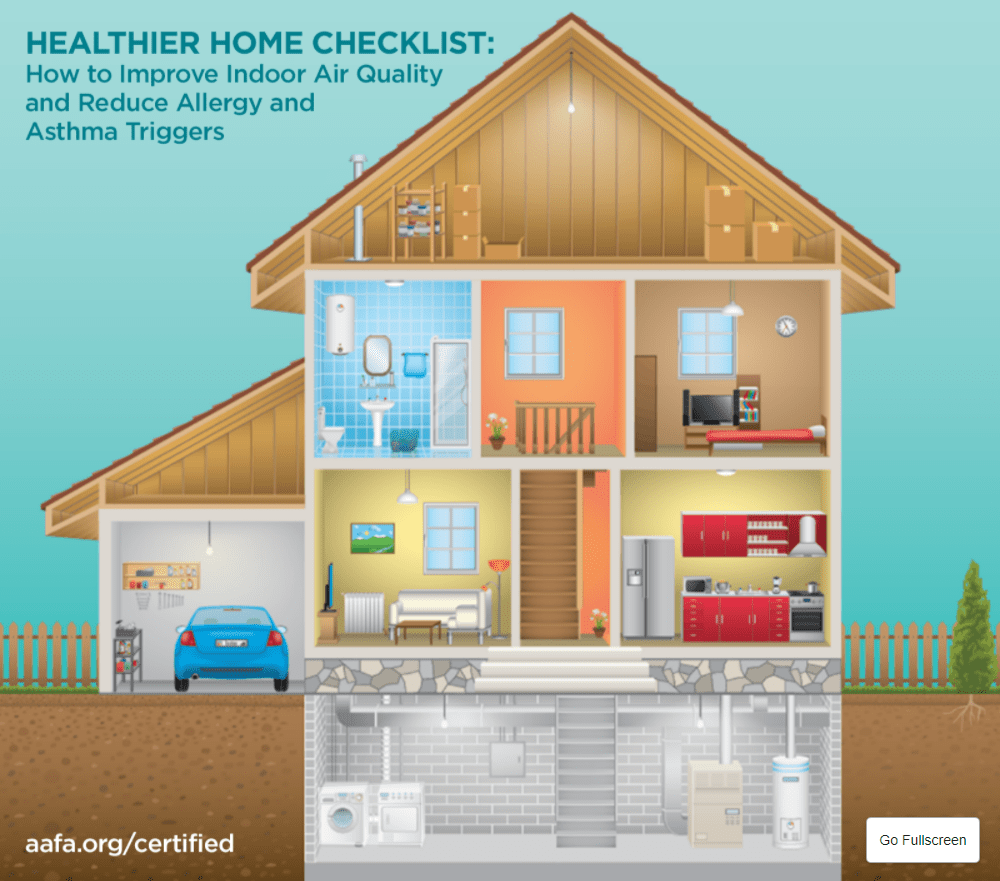Your indoor air can actually be worse than outdoor air. This is because your indoor air is made up of the outdoor air that comes in your home, plus allergens, scents, and chemicals.
After you’ve improved the air quality in your bedroom and kitchen, the next room to work on is your living room.

Improve Your Living Room’s Environment
The living room is the center of activity in your home. That means it’s also a central location for many triggers, irritants, and allergens that affect indoor air quality.
Reduce Fabric to Reduce Allergens
Dust mites and pet dander love living rooms. Our living rooms usually have plenty of fabric and furniture for them to cling to and hide under. By reducing the amount of fabric in your living room, you can better control some of the allergens:
- Choose leather or vinyl furniture over fabric pieces.
- Throw out the throw pillows. They are usually hard to clean, so they can easily collect dust mites and dander.
- Instead of curtains, hang blinds you can dust often. If you choose fabric curtains, choose ones you can wash in 130 F hot water regularly.
- Wash throw blankets weekly in 130 F hot water.
- Clear the clutter. Dust and pet hair like to collect on and under clutter.
- Replace carpet with solid surface flooring with low VOCs and washable rugs.
- If you can’t remove the carpet, have the carpet cleaned.
- Dust using a microfiber or damp cloth and vacuum weekly with a CERTIFIED asthma & allergy friendly® vacuum, if possible.
- If you have house plants or potted herbs, only water them when the soil is dry to prevent mold. Here are some other ways to prevent mold in houseplants:
- Plant them in sterile soil
- Give them more light
- Use a fan to circulate air around the plant
- Trim dead leaves often
Keep Smoke Out
Smoke is a common asthma trigger. There are two sources of smoke to watch out for in the living room: fireplaces and tobacco products.
Smoke from wood-burning fireplaces, wood stoves, pellets, and “clean burning” stoves can pollute your indoor air. The smoke can contain fine particles that irritate your airways. It also contains nitrogen dioxide and carbon monoxide. These are odorless gasses known to cause swelling in the airways in sensitive groups, like people with asthma. It’s best to avoid using the fireplace to heat your living room.
Gas and kerosene space heaters release nitrogen dioxide too. If they are not vented, these will pollute your air too. In fact, children who were around gas heaters as babies are more likely to develop asthma.1
Tobacco smoke is a major asthma trigger and a health hazard for you and people around you. Secondhand and thirdhand smoke causes serious health issues (including asthma) in children and adults.
Reduce Scents and Chemicals
We all want our living rooms to smell nice. But when you have asthma, strong scents can trigger symptoms. Remove candles, wax warmers, diffusers, plug-ins, essential oils, and potpourri to clear the air in your living room and throughout the house.
Think About Open Living Spaces
Many homes now are built with open living spaces. Living rooms and dining rooms often open to kitchens. Vaulted ceilings connect the bottom floor with the top floor. The air quality in your living room affects all the other rooms in your home, and vice versa. Here are some other things to think about when improving the air in your living room:
- Jackets and shoes can bring pollen and outdoor mold into your home. Have your guests and family members remove them at the door to reduce the amount that comes into your living room.
- Think about the air quality of your kitchen if you have an open floor plans. Allergens and pollutants in your adjoining rooms can affect your living room.
- Use a CERTIFIED air cleaner. Make sure you get one large enough to clean the air in your living room. If you have an open floor plan, count the square footage of your adjoining rooms too.
Published October 2017. Updated October 2021.
 Many products promise to help control allergens but not all of them do. When you are shopping for products for your home, look for the CERTIFIED asthma & allergy friendly® mark. It indicates the product has passed our testing standards to help you have a healthier home.
Many products promise to help control allergens but not all of them do. When you are shopping for products for your home, look for the CERTIFIED asthma & allergy friendly® mark. It indicates the product has passed our testing standards to help you have a healthier home.Visit aafa.org/certified to search for CERTIFIED products. There you can also learn more about the asthma & allergy friendly® Certification Program.


Comments (0)